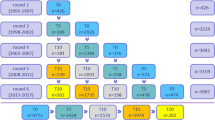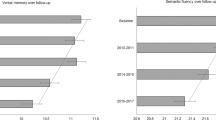Abstract
Interleukin-1β (IL-1β) is considered to have a role in age-related cognitive decline. A recent study has shown that a promoter polymorphism of the IL-1β gene (rs16944) is associated with cognitive performance in elderly males without dementia. In this study, we examined whether polymorphisms of the IL-1β gene also influence cognitive functions in elderly females. Cognitive functions were assessed by the Wechsler adult intelligence scale-revised (WAIS-R) in 99 elderly (⩾60 years) females without dementia. We selected five tagging polymorphisms from the IL-1β gene and examined the associations with the WAIS-R scores. Significant associations were found between verbal intelligence quotient (IQ) and the genotypes of rs1143634 and rs1143633 (P=0.0037 and P=0.010, respectively). No significant associations of rs16944 genotype were found with verbal or performance IQ. However, individuals homozygous for the G allele of rs16944 achieved higher scores in digit span compared with their counterpart, which is consistent with the previous findings in males. These results suggest that IL-1β gene variation may have a role in cognitive functions in aging females as well as males.
Similar content being viewed by others

Introduction
Interleukin-1β (IL-1β) has a significant role in age-related impairment in long-term potentiation in the hippocampus.1 Some genetic studies support this evidence by demonstrating associations between gene variations and cognitive decline in an elderly population. One study2 reported that genetic variation in the IL-1β-converting enzyme gene is associated with better performance on cognitive function and lower IL-1β production levels. Studies investigating the associations between IL-1β gene polymorphisms and cognitive functioning in elderly subjects have shown that a G>A polymorphism of the IL-1β promoter variant rs16944 had detrimental effects on memory performance,3 while rs1143643 and rs1143634 of the IL-1β gene had no significant influence on cognitive performance.4, 5 Consistent with the findings by Baune et al.,3 a recent study by Tsai et al.6 has shown that rs16944 is associated with cognitive performance in elderly males without dementia; those individuals who had the G/G genotype of rs16944 performed better in digit span backward test compared with their counterpart. In this study, following the work by Tsai et al.,6 we examined whether polymorphisms of the IL-1β gene also influence the cognitive functions in elderly females.
Materials and methods
Subjects
Subjects were 99 female healthy volunteers with age 60 years or older recruited from the community through advertisements in free local information magazines and by our website announcement. All subjects were biologically unrelated Japanese, and were screened using the Japanese version of the Mini International Neuropsychiatric Interview7, 8 by a research psychiatrist to rule out any axis I psychiatric disorders. Participants were excluded if they had a prior medical history of psychiatric treatment, central nervous system disease or severe head injury, or if they met Diagnostic and Statistical Manual of Mental Disorders, 4th edition criteria9 for substance abuse or dependence, dementia or mental retardation. Although none of the participants had a systemic infection, eight were under treatment for major systemic illnesses (two with anti-hypertensive agents, one with a diabetes drug, one with an anti-coagulant agent, one with anti-thyroid agents and three with anti-lipidemic agents). All participants were administered the Japanese version of Wechsler adult intelligence scale-revised (WAIS-R)10 by a research psychologist. The study protocol was approved by the ethics committee at the National Center of Neurology and Psychiatry, Japan. After description of the study, written informed consent was obtained from every subject.
Genotyping
Five tagging single nucleotide polymorphisms (SNPs) of the IL-1β gene (rs2853550, rs1143634, rs1143633, rs1143630 and rs16944) were selected by Haploview 4.211 using Japanese and Chinese population in the HapMap SNP data set release 22 (International HapMap Project, http://hapmap.ncbi.nlm.nih.gov/), at an r2 threshold of 0.80 with a minor allele frequency greater than 0.1. Genomic DNA was prepared from the venous blood according to standard procedures. The SNPs were genotyped using the TaqMan 5′-exonuclease allelic discrimination assay (Applied Biosystems, Foster City, CA, USA). Thermal cycling conditions for PCR were one cycle at 95 °C for 10 min followed by 50 cycles of 92 °C for 15 s and 60 °C for 1 min. The allele-specific fluorescence was measured with ABI PRISM 7900 Sequence Detection Systems (Applied Biosystems, Foster City, CA, USA). Genotype data were read blind to the WAIS-R scores. Ambiguous genotype data were not included in the analysis.
Statistical analysis
Mean differences between groups were assessed by analysis of variance. Differences in the WAIS-R scores between the genotypes were tested using analysis of covariance, with age and years of education as covariates. Bonferroni method was used to correct for multiple comparisons among the five SNPs. However, as the subtest scores and the intelligence quotient (IQ) scales of WAIS-R are intercorrelated and thus are not completely independent measures, we did not apply the Bonferroni method for the number of WAIS-R subtests and IQ scales. Statistical analyses were performed using the statistical package for the social sciences (SPSS) version 11.0 (SPSS, Tokyo, Japan). Statistical tests were two tailed and statistical significance was considered when P<0.05.
Results
The characteristics of the subjects and their WAIS-R scores are shown in Table 1. None of the SNPs were found to deviate significantly from Hardy–Weinberg equilibrium. The WAIS-R full scale IQ, verbal IQ (VIQ) and performance IQ (PIQ) were in normal distribution (all P>0.05, Shapiro–Wilk test). The VIQ and PIQ for each genotype of the examined SNPs are presented in Table 2. Significant differences in VIQ were found between the genotypes of rs1143634 and between the genotypes of rs1143633. The association between rs1143634 and VIQ remained significant after multiple test correction (Bonferroni-corrected P=0.018). The association of rs1143633 with VIQ was also significant after multiple test correction when individuals homozygous for T allele were compared with the C allele carriers (Bonferroni-corrected P=0.031). Figure 1 shows the mean scaled scores of the verbal subtests for each genotype of rs1143634 and rs1143633. No significant associations of rs16944 genotype were found with VIQ or PIQ. However, individuals homozygous for the G allele of rs16944 achieved higher scores in the digit span subtest compared with A allele carriers (F=6.24, P=0.014, adjusted for age and years of education).
Discussion
The results indicate that IL-1β gene polymorphisms rs1143634 and rs1143633 may be associated with verbal cognitive function in elderly female subjects. Furthermore, those homozygous for the G allele of rs16944 performed better in digit span test compared with A allele carriers, which was consistent with the findings in the previous study in males.6 Despite the significant associations between VIQ and the genotypes of rs1143634 and rs1143633, the years of education were not significantly affected by the polymorphisms. This suggests that these polymorphisms influenced the cognitive function in old age, but did not have impact on educational attainment during school years. Thus, our findings lend support to the possibility that IL-1β gene variation may have a role in the cognitive deficit in the elderly.
A limitation of this study is that the cross-sectional design did not allow us to compare the time course of the cognitive decline between different genotypes. A prospective study is necessary to determine whether the IL-1β gene polymorphisms affect the cognitive function per se or cognitive decline in the elderly. Further study is still needed to explore the effect of the IL-1β gene variations on cognitive function in various age, gender and ethnic groups.
References
Murray, C. A. & Lynch, M. A. Evidence that increased hippocampal expression of the cytokine interleukin-1 beta is a common trigger for age- and stress-induced impairments in long-term potentiation. J. Neurosci. 18, 2974–2981 (1998).
Trompet, S., de Craen, A. J., Slagboom, P., Shepherd, J., Blauw, G. J., Murphy, M. B. et al. Genetic variation in the interleukin-1 beta-converting enzyme associates with cognitive function. The PROSPER study. Brain 131, 1069–1077 (2008).
Baune, B. T., Ponath, G., Rothermundt, M., Riess, O., Funke, H. & Berger, K. Association between genetic variants of IL-1beta, IL-6 and TNF-alpha cytokines and cognitive performance in the elderly general population of the MEMO-study. Psychoneuroendocrinology 33, 68–76 (2008).
Marioni, R. E., Deary, I. J., Murray, G. D., Fowkes, F. G. & Price, J. F. Associations between polymorphisms in five inflammation-related genes and cognitive ability in older persons. Genes Brain Behav. 9, 348–352 (2010).
Lau, S., Bates, K. A., Sohrabi, H. R., Rodrigues, M., Martins, G., Dhaliwal, S. S. et al. Functional effects of genetic polymorphism in inflammatory genes in subjective memory complainers. Neurobiol. Aging doi:10.1016/j.neurobiolaging.2010.09.003 (in press).
Tsai, S. J., Hong, C. J., Liu, M. E., Hou, S. J., Yen, F. C., Hsieh, C. H. et al. Interleukin-1 beta (C-511T) genetic polymorphism is associated with cognitive performance in elderly males without dementia. Neurobiol. Aging 31, 1950–1955 (2010).
Sheehan, D. V., Lecrubier, Y., Sheehan, K. H., Amorim, P., Janavs, J., Weiller, E. et al. The mini-international neuropsychiatric interview (M.I.N.I.): the development and validation of a structured diagnostic psychiatric interview for DSM-IV and ICD-10. J. Clin. Psychiatry 59 (Suppl 20), 22–33; quiz 34–57 (1998).
Otsubo, T., Tanaka, K., Koda, R., Shinoda, J., Sano, N., Tanaka, S. et al. Reliability and validity of Japanese version of the mini-international neuropsychiatric interview. Psychiatry. Clin. Neurosci. 59, 517–526 (2005).
American Psychiatric Association. DSM-IV: Diagnostic and Statistical Manual of Mental Disorders 4th edn, (American Psychiatric Press, Washington D.C., 1994).
Wechsler, D. The Wechsler Adult Intelligence Scale-Revised (The Psychological Corporation, San Antonio, 1981).
Barrett, J. C., Fry, B., Maller, J. & Daly, M. J. Haploview: analysis and visualization of LD and haplotype maps. Bioinformatics 21, 263–265 (2005).
Acknowledgements
This study was supported by Health and Labor Sciences Research Grants (Comprehensive Research on Disability, Health, and Welfare), Grant-in-Aid for Scientific Research from the Japan Society for the Promotion of Science (JSPS), Core Research of Evolutional Science & Technology (CREST), Japan Science and Technology Agency (JST), the Strategic Research Program for Brain Sciences by the Ministry of Education, Culture, Sports, Science and Technology of Japan (Understanding of molecular and environmental bases for brain health), and Intramural Research Grant for Neurological and Psychiatric Disorders of NCNP (HK).
Author information
Authors and Affiliations
Corresponding author
Ethics declarations
Competing interests
The authors declare no conflict of interest.
Rights and permissions
About this article
Cite this article
Sasayama, D., Hori, H., Teraishi, T. et al. Association of interleukin-1β genetic polymorphisms with cognitive performance in elderly females without dementia. J Hum Genet 56, 613–616 (2011). https://doi.org/10.1038/jhg.2011.56
Received:
Revised:
Accepted:
Published:
Issue Date:
DOI: https://doi.org/10.1038/jhg.2011.56
Keywords
This article is cited by
-
Genetic effect of interleukin-1 beta (C-511T) polymorphism on the structural covariance network and white matter integrity in Alzheimer’s disease
Journal of Neuroinflammation (2017)
-
Genetic variability of interleukin-1 beta as prospective factor from developing post-traumatic stress disorder
Immunogenetics (2017)
-
Association of cognitive performance with interleukin-6 receptor Asp358Ala polymorphism in healthy adults
Journal of Neural Transmission (2012)



